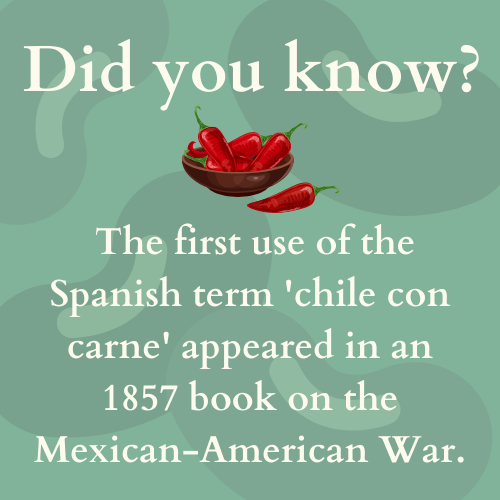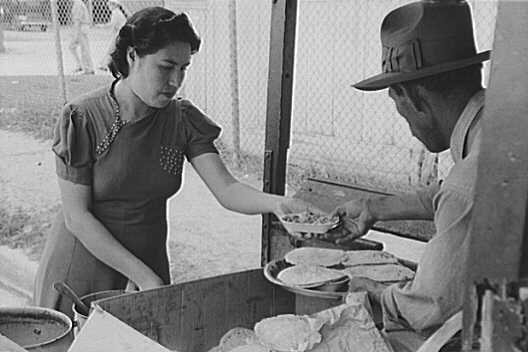Contents
- Learn the legacy of chilli con carne
- Is chilli con carne healthy?
- Your burning chilli con carne questions answered
Rich. Smoky. Meaty. Meatless. Tangy. Creamy. Healthy. Earthy.
An immense melting pot of ingredients, styles and variations, modern flavours of chilli con carne recipes have imaginatively stewed beyond the dish’s humble origins. Once the picante heart of south Texan marketplaces, chilli is now an intercontinental favourite, with everyone from the BBC to your next-door neighbour’s pet tarantula owning their own recipe.
But where, officially, did chilli con carne emerge from, and what makes this spicy sensation a hearty superfood you should be enjoying in the currently crisp new year?
Learn the origin of chilli con carne
Two centuries ago, amidst the smoky hustle and bustle of San Antonio’s public squares, the cooking of this meaty staple was certainly not whipped up with chilli powder in the dazzling kitchens of Jamie Oliver or the Hairy Bikers.
Setting up provisional tables, so-called Chili Queens arrived in the Texan city’s plazas to cook batches of chilli in huge pots over open fires. Serving everyone and anyone from local families and businessmen to soldiers, singers, troubadours and tourists, the Queens’ grub was an illustrious enticement into a hub of music, politics and socialisation.
However, some argue chilli con carne’s genesis dates back much further.
Specifically, 2000 years further, to an indigenous recipe which Ute tribe member Rudy Valdez won the World Championship Chili Cook-off competition with in 1976.
According to Valdez, the original meal excluded beans and was made with horse or deer meat, cornmeal and chile peppers.
A far cry away from the vegan chilli con carne recipes popular today perhaps, but certainly delicious enough for Valdez to triumph in the annual event, hosted each year since 1967 by the International Chili Society.
Identifying the exact founder of chilli is a hard task though.
Early 16th century writings by Franciscan friar Bernardino de Sahagún speak of a chile pepper-seasoned stew eaten in the Aztec capital Tenochtitlan.
Others speculate that sixteen families from the Spanish Canary islands, who were sent to San Antonio in the early-to-mid 1700s, concocted the earliest version of chilli con carne in the form of a spicy, Spanish stew. Under pressure from French invaders, King Philip V of Spain allegedly shipped out the families to settle in the area where they established a meal from beef, hot pepper, garlic and oregano.

Today though, most attribute the meal’s origin to the Chili Queens despite no record existing of a specific woman who founded the chilli recipe.
A mystery to stew over, but at least we can be certain today of the nutritious content this now evolved culinary delight has to offer.
Is chilli con carne healthy?
Exploding across the world’s taste buds, meat, vegetarian and vegan chilli con carne recipes have evolved into a nourishing go-to, rich in protein and healthy fats.
Pinpointing the exact nutritional value of chilli con carne ingredients can be a little tricky though, particularly considering the internet is awash with recipes, each containing their own collection of components.
So we did the work for you. Below are the health benefits from a selection of popular chilli con carne ingredients.
Chile peppers
Used in recipes both archaic and modern, chile peppers are the hot centre of chilli con carne, the capsaicin capsule unleashing spice into this Tex-mex classic. Albeit eaten in small quantities, these fiery fruits contribute to your daily intake of several helpful nutrients.
High in Vitamin C, chile peppers contain a lot of this antioxidant which aids immune function and wound healing. They are also a good source of Vitamin K1, crucial for blood clotting and strong bones, and copper, which is essential for healthy neurons.
Onions
Found in almost every cooked meal, onions are the foundation of great food. They also happen to give a wealth of goodness too, possessing over 25 flavonoids, a class of polyphenolic secondary metabolites which have antioxidant properties. Onions have equally been linked to supporting heart, bone and gut health.
Red kidney beans
Concave-shaped and native to Mexico and Central America, these little beans are cheap, cheerful, and crammed with fibre and protein. As well as being a complex carb, kidney beans can help to control blood pressure, cholesterol, and blood sugar. They are also believed to boost your energy and support regular, cognitive function.
Butternut Squash
This umami-oozing meat alternative which we fill our vegan chilli con carne with has been shown to protect against cognitive decline. Moreover, containing phytonutrients such as zeaxanthin and lutein known as carotenoids, butternut squash has been linked to improving our eye health.
Beef
Consumed in large quantities, red meat has been proven to be bad for us and the environment. But there is no arguing that in small doses, beef is a rich source of iron, zinc and B vitamins.
Vital for the production of red blood cells to carry oxygen around the body, iron is equally needed for gastrointestinal processes and regulating body temperature. Meanwhile, zinc helps to process nutrients from our food whereas B vitamins, of which there are eight, aids everything from healthy brain function to good eyesight to our cardiovascular health.
Original Chili Queen chilli con carne recipe
(Uploaded by Rebecca May Johnson)
Ingredients:
- 900g of beef chuck or stewing beef, cubed into 1-2 inch pieces
- 450g of pork shoulder, cubed into 1-2 inch pieces
- 100g of beef fat cut into small bits (the butcher should give it for free) or suet
- 100g of pork fat cut into small bits
- 3 medium sized onions, roughly chopped
- 6 garlic cloves, minced
- 1 litre of water
- 4 ancho chillies (essential)
- 6 dried red chillies
- 1 serrano chilli (or other similar mexican chilli)
- 1 tablespoon of cumin seeds, toasted then pounded
- 2 tablespoons of Mexican Oregano (or just oregano)
- 1 tablespoon of treacle or dark brown sugar
- 1 tablespoon of vinegar (red wine, white wine, or malt)
- salt
Method:
- Soak the dried chillies in hot water for 20-30 minutes.
- Toss the cubed meat lightly in flour (optional) then add to a large heavy bottomed pan along with the fat, and fry quickly, stirring often for a few minutes until it begins to brown.
- Add the onions and garlic and cook, stirring every 30 seconds until the onions are soft. Don’t have it too hot so they burn.
- Add the water and simmer gently while preparing the chillies.
- Remove the stems and seeds from the chillies and pound in a pestle and mortar or blitz with a hand blender into a paste, along with the cumin seeds too. Mix in the oregano and a hefty pinch of salt.
- Add the chilli mixture and sugar to the pot and simmer on a low heat, not allowing it to boil, for at least 2 hours. If you are worried about it drying out, place a lid half-on or add a bit more water. Skim off some fat.
- Next add the vinegar and salt. Keep adding salt and tasting until you are happy with the seasoning.
Your burning chilli con carne questions answered
Is chilli con carne Mexican or American?
Who invented chilli con carne?
Can chilli con carne be frozen?
Is chilli con carne healthy?
How do you spell chilli con carne?

